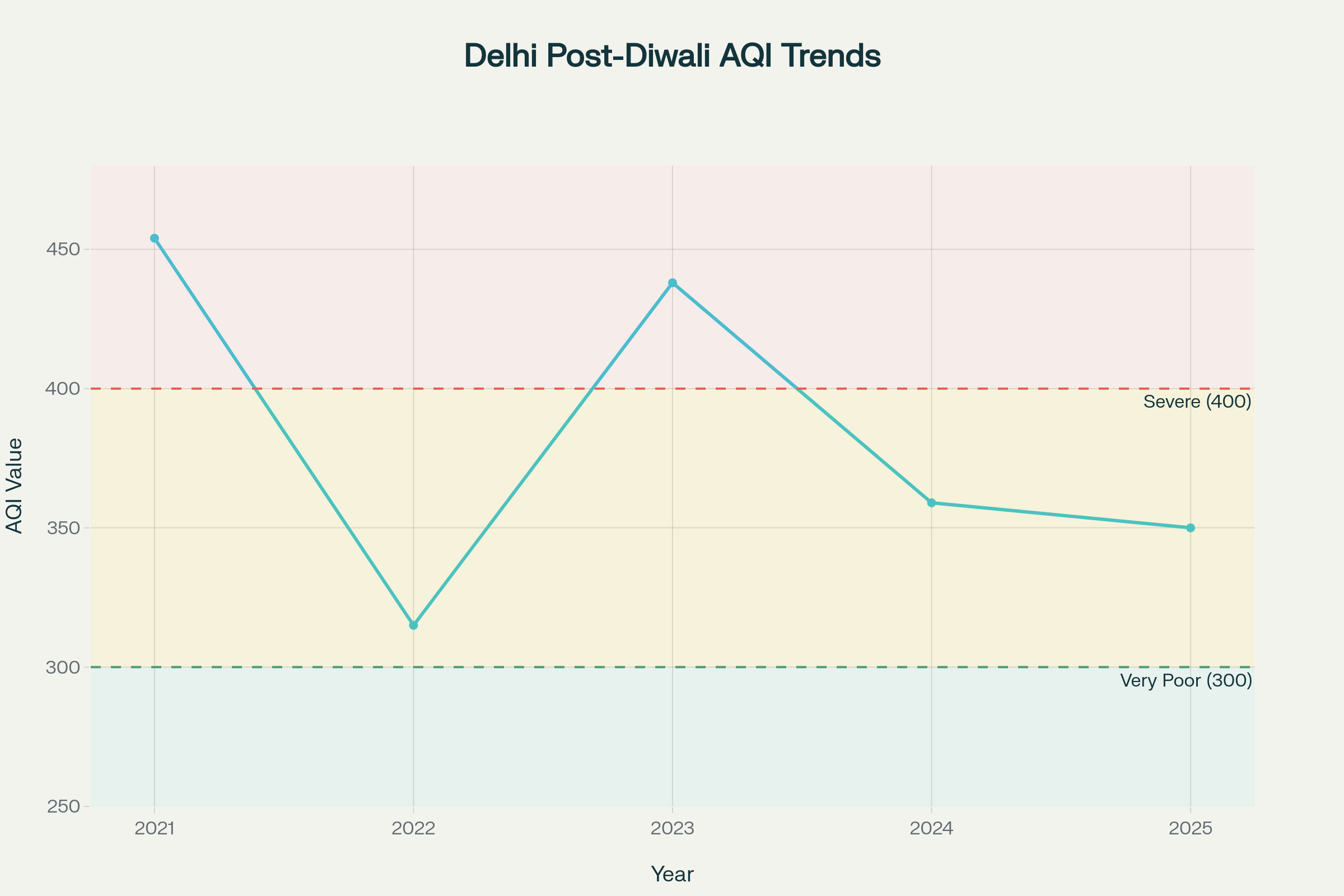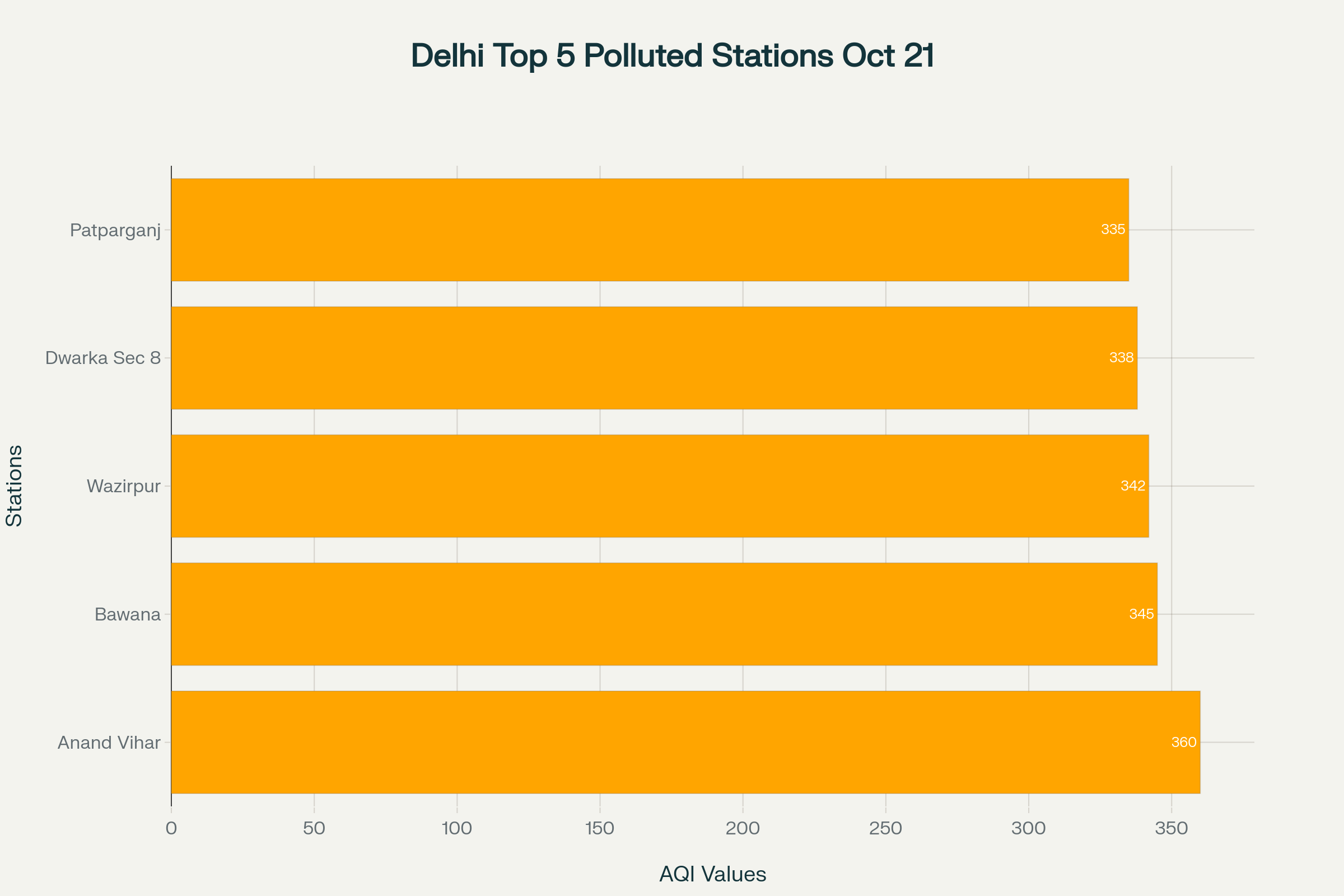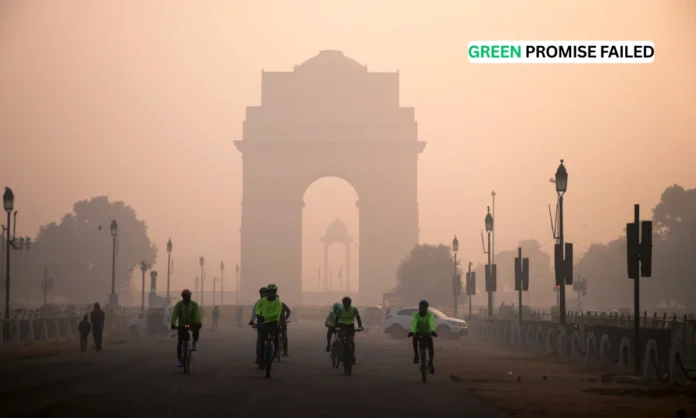Key Highlights
- Delhi recorded AQI of 350 on October 21, 2025, showing green crackers Delhi air quality improvements remain minimal despite technological advances
- NEERI studies confirm green crackers reduce emissions by only 30% compared to conventional firecrackers, insufficient for meaningful air quality enhancement
- Supreme Court’s October 15, 2025 judgment allowed green crackers as a “test case” with comprehensive monitoring to assess green crackers Delhi air quality impact
Opening Overview
Delhi’s inaugural officially sanctioned green Diwali celebration has delivered concerning results that question whether green crackers Delhi air quality improvements can meaningfully address the capital’s persistent pollution crisis. The national capital recorded an Air Quality Index (AQI) of 350 at 8 AM on October 21, 2025, placing green crackers Delhi air quality performance firmly in the “very poor” category despite widespread adoption of eco-friendly alternatives during festival celebrations. This represents the highest post-Diwali pollution measurement in recent years, casting doubt on whether green crackers Delhi air quality enhancement strategies offer viable solutions for cleaner festive observances.
Unfortunately the Delhi govt has consciously decided to promote crackers over public health. Also the SC played along this time by allowing “green crackers”, which hardly reduce pollution & cannot be monitored https://t.co/fFyzHB5Vns
— Prashant Bhushan (@pbhushan1) October 21, 2025
The Supreme Court’s landmark October 15, 2025 judgment had permitted green cracker sales as a controlled experiment, marking a significant shift from complete firecracker prohibition while establishing frameworks to monitor green crackers Delhi air quality effects. However, monitoring stations across Delhi revealed troubling patterns the morning after Diwali, with 36 out of 38 stations recording pollution levels in the “red zone,” indicating that green crackers Delhi air quality benefits remained largely theoretical. The green crackers Delhi air quality experiment, designed to balance cultural traditions with environmental protection, now faces intense scrutiny as empirical data suggests minimal improvement over previous years despite technological advances in firecracker formulations and strict regulatory oversight.
Air Quality Performance Analysis: Green Crackers Show Limited Impact
The effectiveness of green crackers Delhi air quality improvement during 2025 Diwali celebrations has faced intense examination following disappointing pollution measurements that exceeded levels recorded in recent years. Delhi’s post-Diwali AQI of 350 in 2025 significantly surpassed the previous year’s reading of 328, contradicting expectations that green crackers Delhi air quality enhancements would deliver measurable environmental benefits. This deterioration becomes particularly concerning when evaluated against historical trends, as green crackers Delhi air quality performance failed to match even modest improvements seen in previous years without technological interventions.
- Real-time monitoring revealed PM2.5 concentrations breaching safe limits by 15-18 times across multiple stations
- Anand Vihar, Dwarka Sector 8, and Patparganj recorded peak readings above 1,400-1,800 µg/m³
- Four monitoring stations reported “severe” category AQI levels exceeding 400, undermining green crackers Delhi air quality objectives
Central Pollution Control Board (CPCB) data demonstrates that green crackers Delhi air quality implementation failed to prevent typical post-Diwali environmental degradation, with pollution levels spiking sharply throughout Diwali night on October 20, 2025. The Delhi Pollution Control Committee’s real-time monitoring system captured PM2.5 and PM10 concentrations that were 15-20 times higher than permissible standards at several locations, indicating that green crackers Delhi air quality protection measures provided insufficient safeguards against particulate matter emissions. These findings align with environmental experts’ warnings that while green crackers Delhi air quality technology shows promise in laboratory settings, real-world applications demonstrate only marginal improvements representing “less poison” rather than genuine solutions.

Delhi’s Post-Diwali AQI Trends (2021-2025): Green Crackers Implementation Shows Mixed Results
Scientific Assessment: NEERI Technology and Real-World Performance
The Council of Scientific & Industrial Research-National Environmental Engineering Research Institute (CSIR-NEERI) has developed green cracker formulations specifically targeting green crackers Delhi air quality enhancement through emission reductions ranging from 30% to 80% via innovative chemical modifications. Green crackers Delhi air quality improvements are achieved through three major formulation changes: utilizing additives such as zeolite and functionalized zeolites, incorporating water-releasing molecules like boron-based reagents as dust suppressants, and adding metallic composites to enhance combustion efficiency while reducing harmful emissions. The elimination of barium nitrate, a toxic component widely used internationally but banned for green crackers Delhi air quality protection, represents the most significant chemical modification distinguishing eco-friendly varieties from conventional alternatives.
However, laboratory results demonstrating green crackers Delhi air quality benefits have not translated into proportional real-world environmental improvements during actual usage scenarios. Independent research published in environmental science journals indicates that while barium emissions show measurable reduction, the overall green crackers Delhi air quality impact remains limited due to complex interactions between multiple pollutants released during firecracker combustion processes. Environmental scientists emphasize that green crackers Delhi air quality technology, despite certification by the Petroleum and Explosives Safety Organisation (PESO) and approval by CPCB, cannot eliminate fundamental health risks associated with particulate matter and toxic chemical emissions.
- Green crackers utilize strontium and potassium compounds instead of banned barium for improved air quality performance
- NEERI has developed three certified varieties: SWAS, STAR, and SAFAL crackers targeting different emission profiles
- Quality verification relies on QR codes, though counterfeit sales undermine green crackers Delhi air quality objectives
The technology’s effectiveness in delivering green crackers Delhi air quality improvements faces additional challenges from enforcement difficulties and market penetration issues, with NEERI reporting multiple instances of QR code sales to unregistered manufacturers. This regulatory gap undermines intended environmental benefits by allowing conventional firecrackers to be sold under false green certification, significantly diluting the overall impact of green crackers Delhi air quality initiatives.

Most Polluted Delhi Areas Post-Green Diwali 2025: Monitoring Station AQI Readings
Supreme Court’s Monitoring Framework and Implementation Challenges
The Supreme Court’s October 15, 2025 judgment established comprehensive monitoring protocols specifically designed to evaluate green crackers Delhi air quality impacts as part of a carefully structured experimental approach. Chief Justice B.R. Gavai’s bench implemented strict conditions including designated sale locations, police patrol teams for enforcement, and mandatory air quality monitoring from October 14-25, 2025, to generate empirical evidence about green crackers Delhi air quality effectiveness. The Court’s framework required Central Pollution Control Board collaboration with State Pollution Control Boards to monitor AQI changes, collect soil and water samples from high-usage areas, and compile comprehensive assessment reports documenting green crackers Delhi air quality performance.
Implementation challenges emerged immediately as celebrations extended beyond Court-mandated timeframes, with widespread violations reported that compromised green crackers Delhi air quality monitoring objectives. Police monitoring teams documented continued firecracker usage well past midnight, undermining the controlled testing environment essential for accurate assessment of green cracker Delhi air quality changes. The violation of timing restrictions, combined with suspected smuggling of conventional firecrackers, complicated efforts to isolate green crackers Delhi air quality contributions from other pollution sources.
- Court mandated green cracker sales exclusively from October 18-20, 2025, to control variables affecting air quality assessment
- Patrol teams were assigned to verify QR codes and prevent unauthorized sales that could skew green crackers Delhi air quality results
- Comprehensive monitoring covered air, water, and soil quality parameters to measure complete environmental impact
The Supreme Court explicitly characterized this relaxation as temporary, emphasizing that future decisions regarding firecracker usage would depend entirely on monitoring results and documented green crackers Delhi air quality improvements. Justice K. Vinod Chandran noted that the Court balanced competing interests while maintaining that environmental concerns must take precedence, particularly given the critical importance of green cracker Delhi air quality outcomes for public health. This judicial approach reflects recognition that complete prohibition may be less effective than regulated usage with enhanced monitoring of green crackers Delhi air quality performance.
Economic and Social Implications of Green Technology Transition
The transition to green crackers has generated significant economic disruption within India’s traditional firecracker manufacturing sector, particularly affecting producers who must now adapt their operations to meet green crackers Delhi air quality standards. Green cracker production requires specialized formulations, NEERI technology transfer, and enhanced quality control measures that increase manufacturing costs by approximately 15-20% compared to conventional varieties, impacting the economics of green crackers Delhi air quality compliance. This price differential has created consumer resistance, with shopkeepers reporting that while 70% of customers inquire about green options, many ultimately choose conventional alternatives due to affordability concerns despite green cracker Delhi air quality benefits.
Industry representatives have welcomed the Supreme Court’s decision to allow green cracker sales, viewing it as essential for preserving livelihoods while supporting green crackers Delhi air quality improvement initiatives. The Court acknowledged these economic realities in its judgment, noting that complete prohibition had disrupted industry operations while failing to eliminate firecracker usage, potentially undermining green crackers Delhi air quality objectives through increased smuggling of unregulated varieties. Licensed traders faced particular challenges as expired licenses during the ban period required renewal, adding administrative complexity to the already challenging transition toward green crackers Delhi air quality compliance.
Consumer awareness campaigns promoting green crackers Delhi air quality benefits have shown mixed results, with environmental groups arguing that marketing eco-friendly alternatives creates false security about their safety. Public health advocates maintain that promoting reduced pollution rather than elimination sends incorrect messages about acceptable health risks, potentially undermining broader green crackers Delhi air quality education efforts. This debate reflects broader challenges in balancing cultural practices with environmental responsibility, particularly when festival celebrations carry deep social significance for millions while green cracker Delhi air quality considerations require behavioral modifications.
Closing Assessment: Future of Green Crackers Delhi Air Quality Initiatives
Delhi’s green Diwali experiment has produced sobering evidence that current green crackers Delhi air quality technology alone cannot solve fundamental pollution challenges associated with firecracker usage during festivals. The October 21, 2025 AQI reading of 350 represents the highest post-Diwali pollution measurement in three years, despite widespread adoption of NEERI-certified alternatives and comprehensive monitoring protocols designed to optimize green cracker Delhi air quality outcomes. This outcome challenges assumptions that 30% emission reductions would translate into proportional environmental improvements, highlighting complex factors that determine ambient green crackers Delhi air quality performance beyond technological specifications.
The Supreme Court’s experimental framework, while comprehensive in design, faced implementation challenges that may have compromised scientific validity as an assessment tool for green crackers Delhi air quality effectiveness. Violations of timing restrictions, suspected smuggling of conventional varieties, and enforcement gaps in QR code verification systems all contributed to conditions that differed substantially from controlled environments necessary for accurate green cracker Delhi air quality impact measurement. Future policy decisions must account for these practical limitations when evaluating whether current green crackers Delhi air quality technology represents a viable compromise between cultural traditions and environmental protection.
Environmental scientists increasingly advocate for comprehensive approaches that address firecracker pollution as part of broader air quality management strategies rather than relying solely on green cracker Delhi air quality technological solutions that provide marginal improvements. The green Diwali experiment demonstrates that while innovation in firecracker formulations can reduce certain emissions, the scale of pollution generated during mass usage events requires more fundamental changes in celebration practices and regulatory enforcement beyond current green crackers Delhi air quality capabilities. As Delhi prepares for continued air quality challenges, lessons learned from this green cracker Delhi air quality trial will inform future decisions about balancing festive traditions with urgent public health needs in one of the world’s most polluted urban environments.


